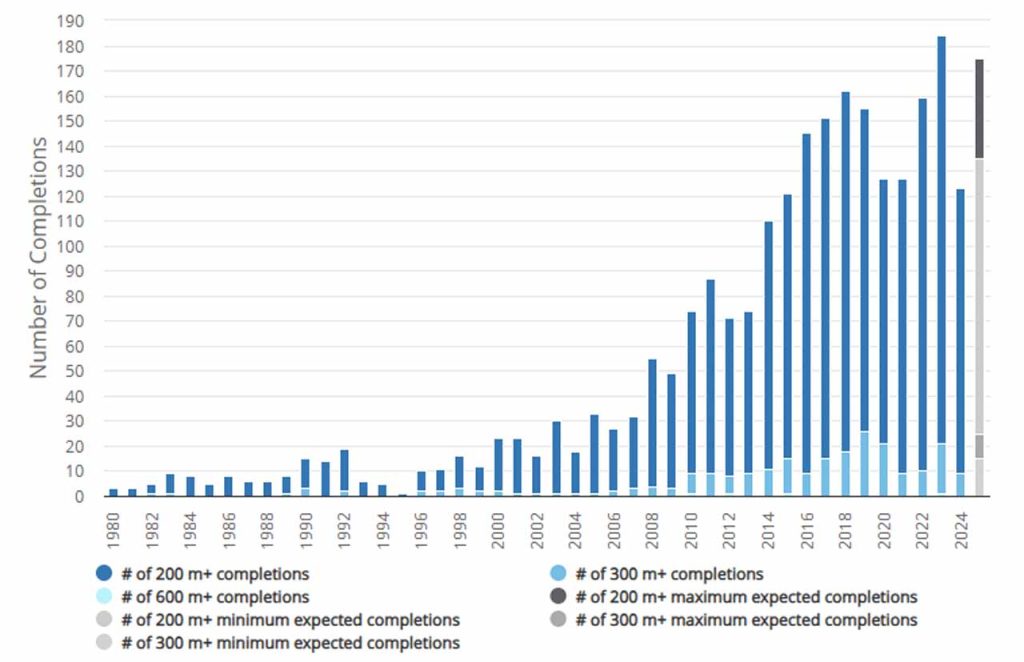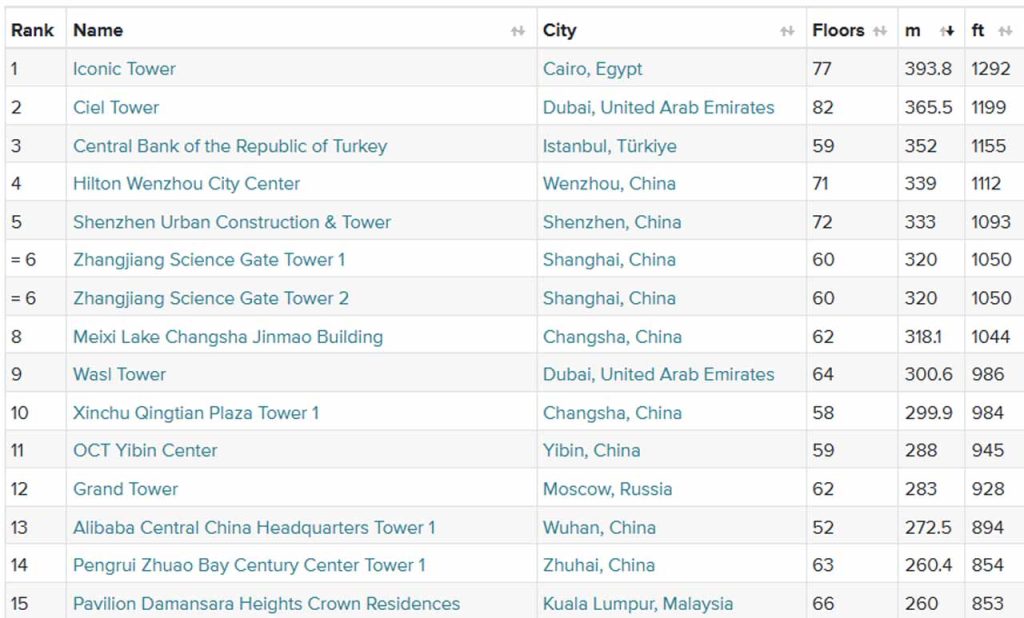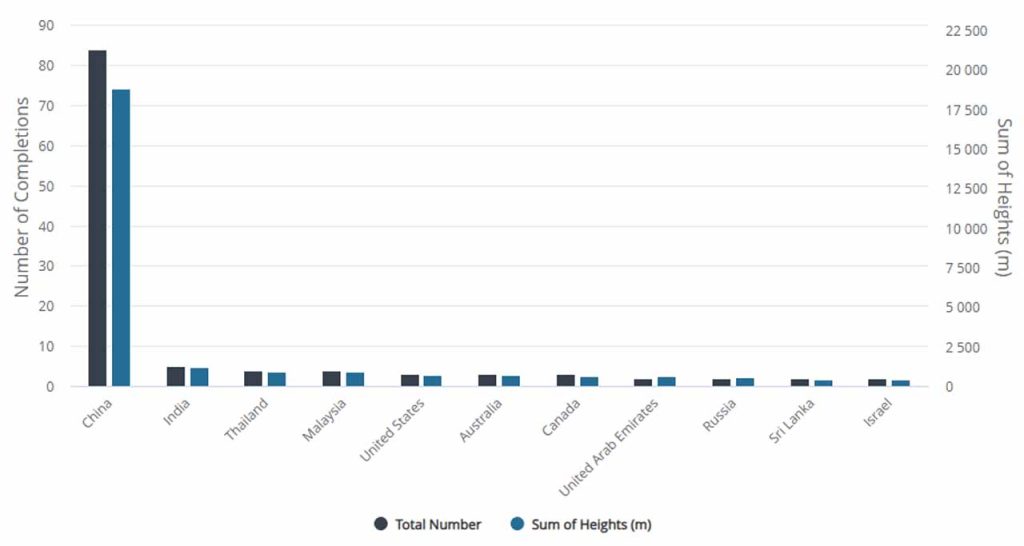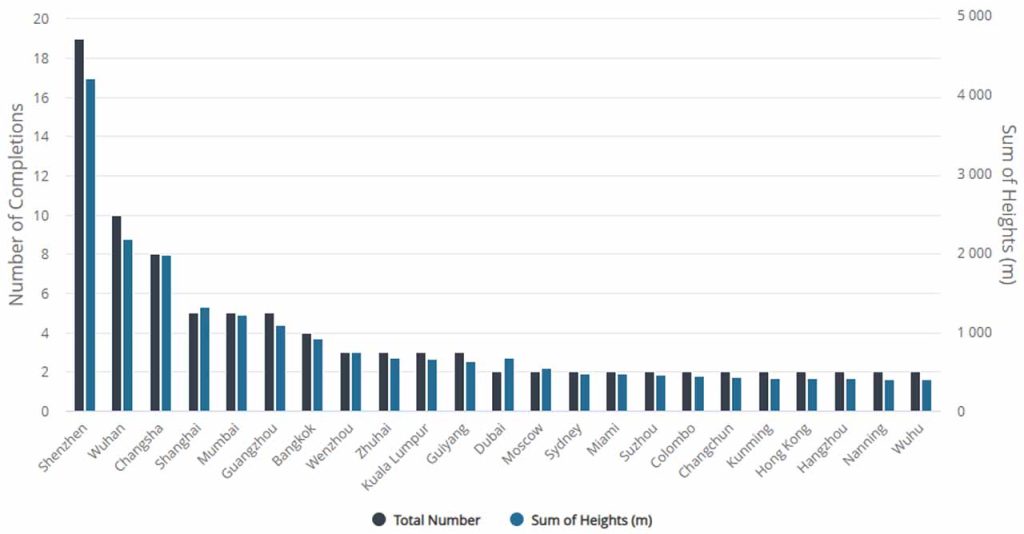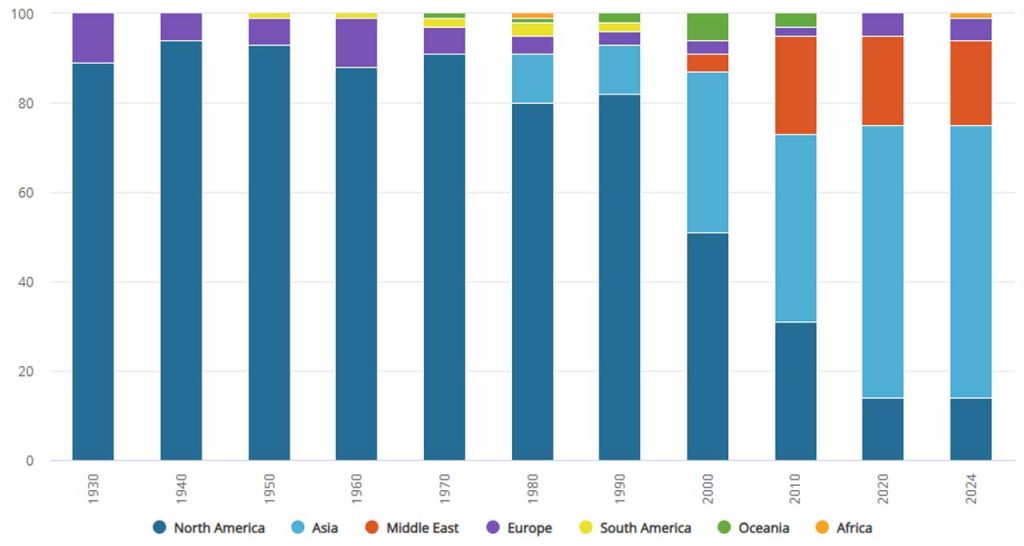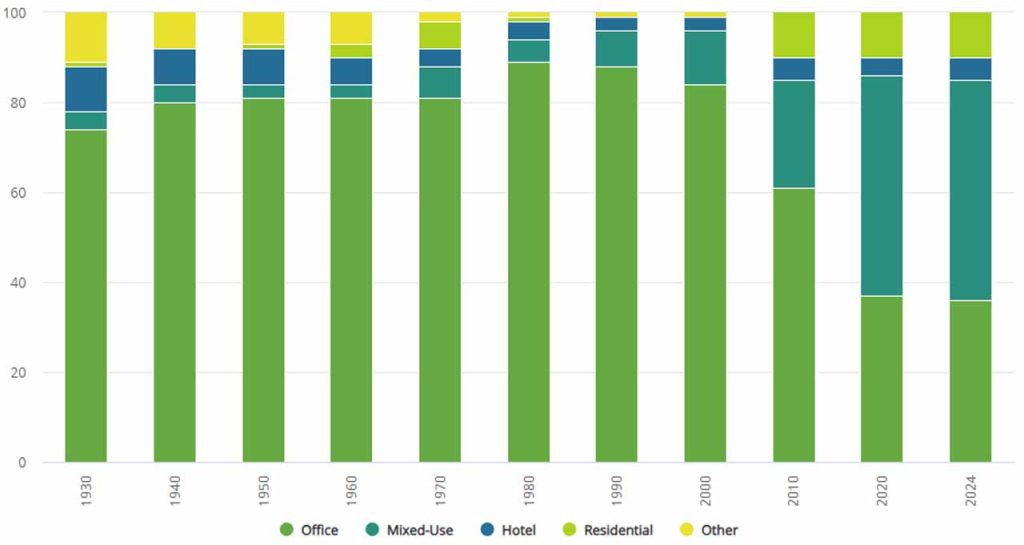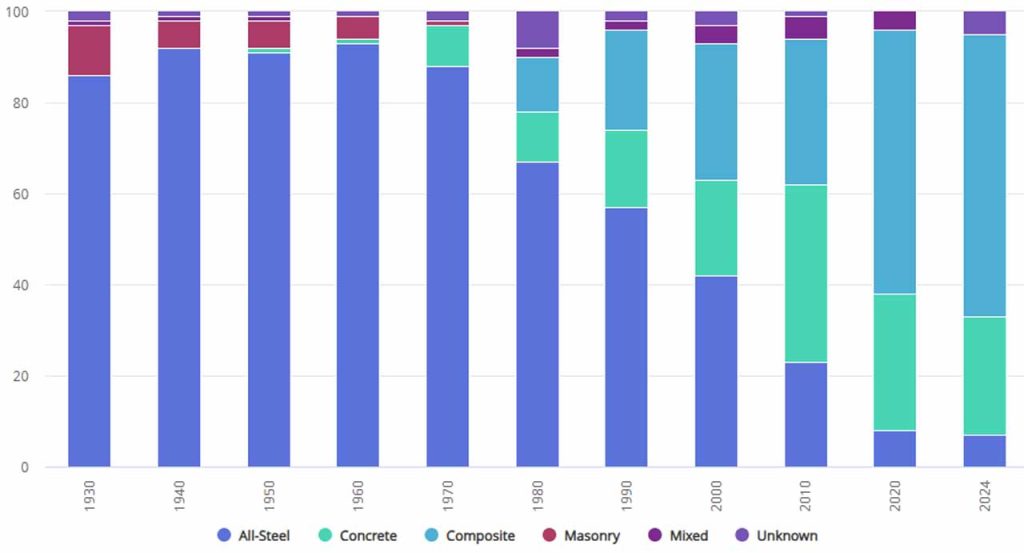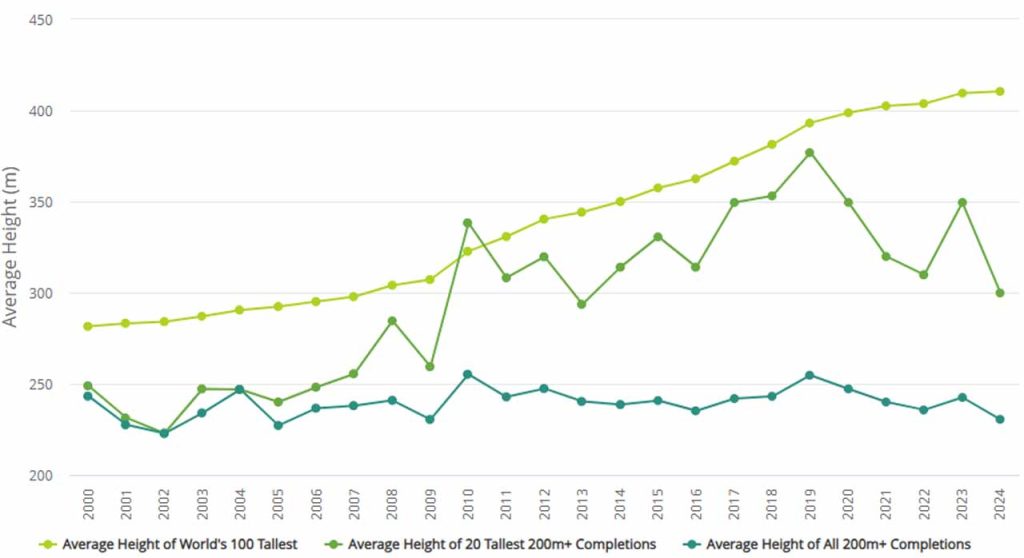Report reveals shifting global skyline and new market realities.
submitted by CTBUH
The Council on Tall Buildings and Urban Habitat (CTBUH) released its 2025 Trends & Forecasts report, which delivers an in-depth analysis of the current state and trajectory of tall building construction worldwide. The report captures key industry movements, including new geographic milestones, economic opportunities and challenges and the ongoing evolution of skyscraper design and function. It is an essential resource for architects, engineers, developers, urban planners and other professionals navigating the ever-changing international tall building landscape.
CTBUH CEO Javier Quintana de Uña said:
“The global tall building industry is experiencing a dynamic transformation. We continue to witness significant completions and milestones — such as Africa’s first-ever supertall building — and we’re encouraged by an accelerating trend for renewing and repositioning older structures, a movement that simultaneously preserves architectural heritage and advances the prospect of more sustainable urban development.”
Key findings from the 2025 Trends and Forecasts report:
- The global count of 200-m-plus buildings now exceeds 2,400, doubling since 2017.
- 2024 marked the 11th consecutive year with more than 100 completions of 200-m-plus buildings.
- Iconic Tower, Cairo, Egypt (393.8 m), became Africa’s first supertall (300-m-plus) building and the tallest completion of 2024. This is the first time that Cairo has completed the tallest building of the year, and it nearly triples Cairo’s previous tallest building height record (last set in 1994 by the Ministry of Foreign Affairs building, 143 m).
- For the first time, buildings in Egypt and Türkiye entered the World’s 100 Tallest Buildings list, marking a significant geographic diversification in high-rise construction.
- A record 256 stalled or “on hold” projects worldwide contributed to fewer completions in 2024, signaling continued challenges into 2025.
“There’s a need for vigilance, too,” continued Quintana de Uña. “The rise in stalled projects underscores the volatility in today’s construction landscape. As we move forward, resilience and adaptability will be crucial in shaping the future of vertical urbanism.”
2024
After 2023 set a new tall building record with 184 completions, 2024 saw a steep 33.2% drop-off, with 123 buildings of 200 m or greater in height completing. Globally, the world has completed a total of 2,416 200-m-plus buildings and 241 supertall (300-m-plus) buildings through 2024. The number of 200-m-plus buildings worldwide has now doubled since 2017, and another 472 are currently under construction.
NOTE: This report reflects completion statistics as of the end of 2024. The last building to be updated on this report was on February 6.
The 123 completions in 2024, while significantly lower than the prior year, still mark the 11th year in a row with more than 100 such completions.
As of the end of 2024, 210 cities in 41 countries have at least one complete 200-m-plus building. An additional 23 cities in three countries have at least one under-construction 200-m-plus building.
Even amidst a nationwide slowdown in tall building construction, China continues to lead annual 200-m-plus completions. Of the 2,416 such buildings in the world, 1,249 are in China.
Eight cities got a new tallest building, as shown in Figure 1. The number of cities completing a 200-m-plus building (54) was down from 2023’s 60 cities, a decrease of 10% from 2023, and down from a peak of 68 cities in 2017.
Impact on the World’s 100 Tallest
World’s 100 Tallest by Region
With the completion of Iconic Tower, Africa has re-entered the World’s 100 Tallest for the first time since 1985. Asia (excluding the Middle East) dipped slightly from its record high of 63 out of 100 buildings, set in 2023. The Middle East gained one more entrant into the 100 Tallest, and Europe and North America held steady at five and 14 buildings, respectively.
World’s 100 Tallest by Function
Two more all-hotel buildings joined the 100 Tallest in 2024, displacing two other mixed-use projects. The number of all-office and all-residential buildings stayed the same compared to 2023, at 36 and 10, respectively.
World’s 100 Tallest by Material
There were no changes in the material makeup of the 100 Tallest between 2023 and 2024. Composite buildings still represent the largest share of this group (62), with all-concrete (26), all-steel (7) and mixed-structure (5) buildings comprising the remainder.
World’s 100 Tallest Average Building Height
The average height of all completions in 2024 was 230.4 m — a 5% decrease from 2023, which had an average completion height of 242.5 m. Despite this decrease, 2024’s new additions to the World’s 100 Tallest increased the average height of that group to 410.5 m in 2024. A total of four buildings entered the 100 tallest in 2024: Iconic Tower, Cairo, at 393.8 m; Ciel Tower, Dubai, at 365.5 m; Central Bank of the Republic of Türkiye, Istanbul, at 352 m; and Hilton Wenzhou City Center, Wenzhou, at 339 m.
Geographic and Functional Shifts
- China remains a dominant player in the worldwide tall building arena, accounting for more than 60% of global 200-m-plus completions in 2024. But the composition of the World’s 100 Tallest Buildings is evolving: Asia’s share declined slightly from 63% in 2023 to 61% in 2024, while the Middle East gained one entry, and Africa rejoined the rankings for the first time since 1985.
- Mumbai, India, completed five tall buildings this year, the most of any city outside China. From 2020 to 2024, the city added 32 buildings over 200 m, matching Hangzhou, China, which ranks 20th globally for such structures. Some projects in Mumbai faced long construction pauses before resuming, highlighting opportunities for future completions. One example is Palais Royale, an imminently anticipated 300-m-plus tower that began in 2008 and started delivering residences after receiving a partial occupancy permit in October.
- Functional shifts are also apparent: Two new hotel buildings entered the World’s 100 Tallest Buildings list, displacing mixed-use projects, while office and residential tall buildings remained steady at 36 and 10, respectively.
- Buildings under 200-m-tall are increasingly being converted or repurposed to meet changing market demands and sustainability goals. With office vacancy rates rising, many of these buildings are being transformed into residential, hotel or mixed-use spaces. This shift highlights a growing industry preference for adapting and reusing existing structures rather than tearing them down, making better use of underutilized buildings in more flexible and resilient ways.
Economic and Supply Chain Pressures
The tall building sector is feeling the impact of rising interest rates, post-pandemic supply chain corrections and tightened financing. Delays in construction timelines have increased, and developers worldwide are reassessing their portfolios amid uncertain economic conditions.
Jason Barr, professor of Economics at Rutgers University-Newark and a member of the CTBUH Height and Data Committee, said:
“The combination of financial uncertainty and evolving urban demand is reshaping the global skyline. We are witnessing a recalibration period where developers are more cautious, and this is reflected in the number of stalled projects.”
Predictions for 2025
As CTBUH surveys the tall building landscape for 2025, there are a record number of 200-m-plus projects on hold globally (260). Of these, 190 are in China, where curtailed financing has led to the high-profile difficulties for real estate developers in the past two years. As many of these projects have made substantial upward progress, they will likely complete eventually, but the outlook for 2025 thus far is characteristic of 2024 — decrease in overall completions from the peak in 2023.
There are 472 buildings more than 200 m that are currently under construction or topped-out, and 85 of those are supertalls. At least 135 buildings 200 m or taller are expected to be completed in 2025, with 12 to 20 expected to reach supertall status (300-m-plus). Jeddah Tower, the world’s first planned 1,000-m building, resumed construction in late 2024, signaling renewed optimism for megatall (600-m-plus) projects.
While market pressures persist, new geographic entries and advancements in construction technology will shape the next wave of tall buildings. The CTBUH 2025 Trends & Forecasts report provides a wide range of interactive data — including breakdowns of the World’s 100 Tallest Buildings by region, function, material and average height trends — that help industry professionals keep abreast of these developments.
About CTBUH
Get more of Elevator World. Sign up for our free e-newsletter.

